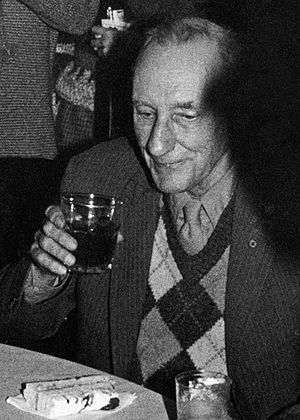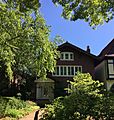William S. Burroughs facts for kids
Quick facts for kids
William S. Burroughs
|
|
|---|---|

Burroughs in 1983
|
|
| Born | William Seward Burroughs II February 5, 1914 St. Louis, Missouri, U.S. |
| Died | August 2, 1997 (aged 83) Lawrence, Kansas, U.S. |
| Pen name | William Lee |
| Occupation | Author |
| Alma mater | Harvard University |
| Genre | Beat literature, surrealism |
| Literary movement | Beat Generation, postmodernism |
| Notable works | Junkie (1953) Naked Lunch (1959) The Nova Trilogy (1961–1964) Cities of the Red Night (1981) The Place of Dead Roads (1983) |
| Spouse | Ilse Klapper (1937–1946) Joan Vollmer (1946–1951) |
| Children | William S. Burroughs Jr. |
| Relatives | William Seward Burroughs I (grandfather) Ivy Lee (maternal uncle) |
| Signature | |
William Seward Burroughs II (February 5, 1914 – August 2, 1997) was an American writer and visual artist. He is known as a key figure of the Beat Generation and an important postmodern author. His work greatly influenced popular culture and literature.
Burroughs wrote many books, including eighteen novels and novellas. He also published six collections of short stories and four collections of essays. Five books of his interviews and letters have also been released. Early in his career, he was briefly known by the pen name William Lee.
Beyond writing, Burroughs worked with many musicians and performers. He appeared in films and created thousands of visual artworks. His "Shotgun Art" is especially famous. Burroughs is perhaps best known for his third novel, Naked Lunch (1959). Many people consider him one of the most important writers of the 20th century.
Contents
Early Life and Education
William S. Burroughs was born in 1914 in St. Louis, Missouri. He was the younger of two sons. His parents were Mortimer Perry Burroughs and Laura Hammon Lee. His family had a long history in St. Louis.
His grandfather, William Seward Burroughs I, started the Burroughs Adding Machine company. This company later became the Burroughs Corporation. William's mother's brother, Ivy Lee, was a pioneer in advertising. He worked as a publicist for the Rockefeller family. William's father ran an antique and gift shop.
As a child, Burroughs became very interested in magic and the occult. These topics often appeared in his later writings. He once described seeing a green reindeer in the woods as a child. He called it a totem animal. He also saw ghostly grey figures playing in his bedroom.
Burroughs lived on Pershing Avenue in St. Louis' Central West End as a boy. He went to John Burroughs School in St. Louis. His first published essay, "Personal Magnetism," appeared in the John Burroughs Review in 1929. This essay was about telepathic mind-control.
He then attended the Los Alamos Ranch School in New Mexico. He found this school difficult. He later said he left the school on his own. He convinced his family to let him stay in St. Louis during Easter vacation.
Burroughs later attended Harvard University. He studied English and then anthropology as a postgraduate. He also went to medical school in Vienna. In 1942, he joined the U.S. Army during World War II. However, he was turned down by the Office of Strategic Services and the Navy.
In 1943, while living in New York City, he met Allen Ginsberg and Jack Kerouac. Their friendship and shared ideas helped create the Beat Generation. This group later had a big impact on the 1960s counterculture.
Life with Joan Vollmer
In 1944, Burroughs started living with Joan Vollmer Adams. They shared an apartment with Jack Kerouac and his first wife, Edie Parker. Joan soon became pregnant with Burroughs' child. Their son, William S. Burroughs Jr., was born in 1947.
In 1950, Burroughs, Vollmer, and their children moved to Mexico. Their time in Mexico was difficult.
One night at a party, Burroughs was involved in a tragic accident that led to Joan Vollmer's death. He later said his gun accidentally fired. Burroughs spent 13 days in jail. His brother helped arrange his release on bail. After returning to the United States, Burroughs was found responsible for her death and received a suspended sentence.
After this event, Vollmer's daughter, Julie Adams, went to live with her grandmother. William S. Burroughs Jr. went to St. Louis to live with his grandparents.
Burroughs described Vollmer's death as a very important event in his life. He felt it pushed him to write more.
Literary Career and Works
Much of Burroughs' writing was experimental and often included characters who might not always tell the full truth. Many of his works were based on his own life. He lived in places like Mexico City, London, Paris, and Tangier International Zone near Morocco. He also traveled in the Amazon rainforest. These places often appeared in his novels and stories.
With Brion Gysin, Burroughs helped make the "cut-up" method popular. This is a way of writing where you cut up text and rearrange it to create new meanings. He used this method a lot in works like The Nova Trilogy (1961–1964). Burroughs' work also often included themes of mystical, occult, or magical ideas. These were always important to Burroughs, both in his stories and in his real life.
Burroughs' main works can be divided into four periods:
- Early Work (early 1950s)
- Books like Junkie, Queer, and The Yage Letters are more straightforward stories. They are about Burroughs' time in Mexico City and South America.
- The Cut-Up Period (mid-1950s to mid-1960s)
- This period includes works such as Naked Lunch, The Word Hoard, The Soft Machine, Nova Express, and The Ticket That Exploded.
- Experiment and New Ideas (mid-1960s to mid-1970s)
- During this time, Burroughs continued his experimental writing. He also added more political ideas and explored different forms like film and sound recordings. A very important work from this time is The Third Mind (with Brion Gysin), which was announced in 1966 and published later. The main novels from this period are The Wild Boys and Port of Saints. He also wrote many articles, short stories, and other works, often with Brion Gysin.
- The Red Night Trilogy (mid-1970s to mid-1980s)
- This series includes Cities of the Red Night, The Place of Dead Roads, and The Western Lands. In these books, Burroughs created a complete world of his own myths and stories.
Burroughs also wrote many essays and autobiographical pieces. One book, My Education: A Book of Dreams, gives a detailed account of his own dreams.
In 1981, Burroughs moved to Lawrence, Kansas, where he lived for the rest of his life. He once told a reporter that he liked living in Kansas because it was peaceful and less expensive. He also enjoyed fishing and shooting in the countryside. In 1984, he signed a deal for seven books with Viking Press. This deal included publishing his previously unreleased 1952 novel Queer. With the money from this deal, he bought a small house.
In 1983, Burroughs was accepted into the American Academy of Arts and Letters. This happened after several attempts by Allen Ginsberg to get him in. Burroughs attended the ceremony in May 1983.
By this time, Burroughs was seen as a symbol of the counterculture. In his later years, he spent time with younger friends. In the 1980s, he worked with many performers, including Bill Laswell's Material, Laurie Anderson, and Throbbing Gristle. Burroughs and R.E.M. worked together on the song "Star Me Kitten." In 1989, he appeared with Matt Dillon in Gus Van Sant's film, Drugstore Cowboy.
In 1990, he released a spoken word album called Dead City Radio. It featured music from producers Hal Willner and Nelson Lyon, and the band Sonic Youth. He also worked with Tom Waits and director Robert Wilson on The Black Rider, a play that opened in Hamburg in 1990. In 1991, director David Cronenberg made Naked Lunch into a movie, which was well-received.
Visual Art and Recognition
In 1982, Burroughs developed a unique painting technique. He would place spray paint cans in front of blank surfaces and then shoot at them with a shotgun. This created splattered and shot panels and canvases. These artworks were first shown in New York City in 1987.
By this time, he had developed a full visual art practice. He used ink, spray paint, collage, and unusual tools like mushrooms and plungers to apply paint. He also created "file-folder paintings" using these materials and "automatic calligraphy" inspired by Brion Gysin. He originally used the folders to mix paints but then realized they could be artworks themselves. He also used many of these painted folders to store his writings and letters.
Burroughs continued to create a lot of visual art until his last years. His work has been shown in more than fifty galleries and museums around the world. These include the Royal Academy of the Arts, Centre Pompidou, and the Guggenheim Museum.
In 1990, Burroughs received a star on the St. Louis Walk of Fame.
In June 1991, Burroughs had triple bypass surgery.
In 1983, Burroughs was elected to the American Academy of Arts and Letters. In 1984, France awarded him the Ordre des Arts et des Lettres. Fellow writer Jack Kerouac called Burroughs the "greatest satirical writer since Jonathan Swift". J. G. Ballard thought Burroughs was "the most important writer to emerge since the Second World War". Norman Mailer said he was "the only American writer who may be conceivably possessed by genius."
He became a member of a chaos magic group called the Illuminates of Thanateros in 1993.
He was a voice actor in the 1995 video game The Dark Eye, which was based on the works of Edgar Allan Poe. In the game, he recited "Annabel Lee".
Burroughs' last filmed appearance was in the music video for "Last Night on Earth" by the band U2. It was filmed in Kansas City, Missouri.
Death
William S. Burroughs died on August 2, 1997, in Lawrence, Kansas. He passed away from complications of a heart attack he had the day before. He was buried in his family's plot at Bellefontaine Cemetery in St. Louis, Missouri. His grave marker has his full name and the words "American Writer." His grave is next to the white granite monument of his grandfather, William Seward Burroughs I.
Works Published After His Death
Since Burroughs' death in 1997, several collections of his work have been published. A few months after he died, a collection called Word Virus was released. It included writings from his entire career. This book also had a small part of And the Hippos Were Boiled in Their Tanks, a novel Burroughs wrote with Jack Kerouac. The complete manuscript of And the Hippos Were Boiled in Their Tanks was published for the first time in November 2008.
A book of his journal entries from the last months of his life, called Last Words, was published in 2000. Another book, a memoir titled Evil River, has been announced but has not yet been published.
New, larger, or more complete editions of many of his texts have also been published recently. These "Restored Text" or "Redux" editions include extra material and essays, or they put back parts that were edited out of earlier versions.
Images for kids
-
David Bowie (left) and Burroughs (middle) with journalist A. Craig Copetas (right) for an interview in February 1974 for Rolling Stone.
See also
 In Spanish: William Burroughs para niños
In Spanish: William Burroughs para niños




